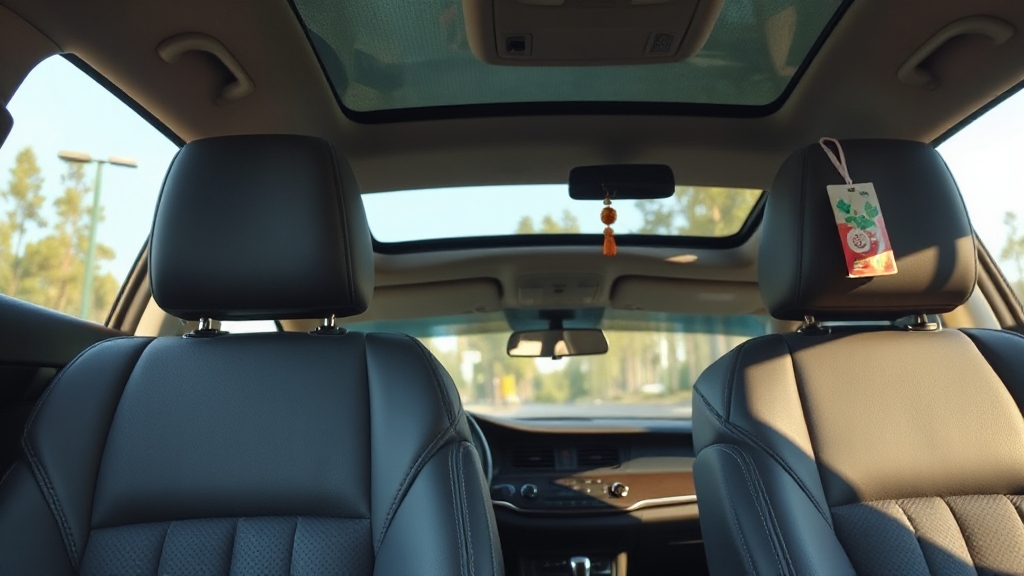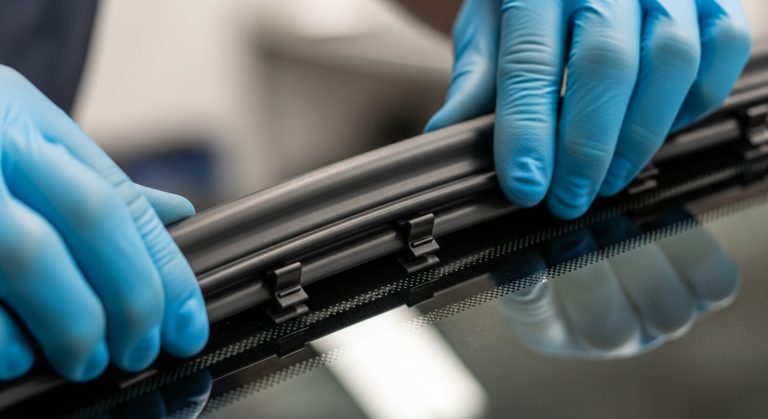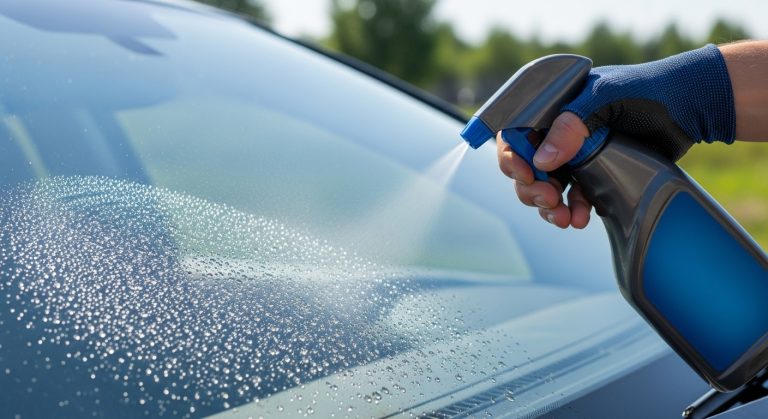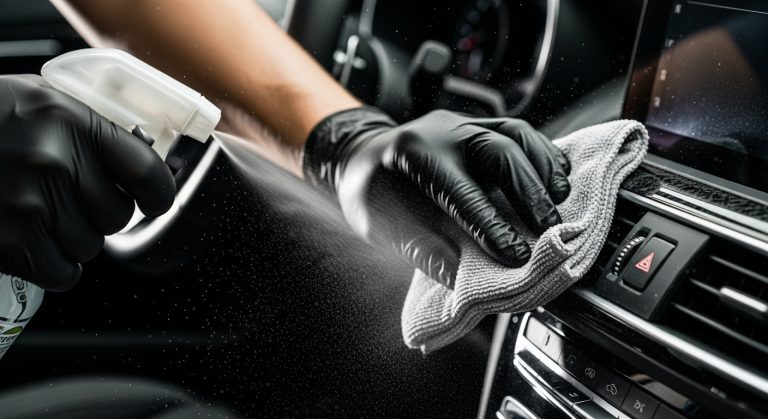To keep that new car smell longer, regularly vacuum and wipe all interior surfaces with pH-balanced cleaners, and promptly clean spills to prevent odors. Maintain air quality by cleaning vents and replacing cabin filters to avoid bacteria buildup. Avoid smoking and food crumbs inside your vehicle, and use odor neutralizers or absorbers like baking soda to manage trapped smells. You’ll also want to understand how ventilation, protective coatings, and deep cleaning contribute to preserving freshness over time.
Key Takeaways
- Regularly clean and vacuum the interior to remove dust, debris, and spills that can trap or create odors.
- Maintain and replace cabin air filters to prevent mold, bacteria, and contaminants from degrading air quality.
- Use odor neutralizers and natural absorbers like baking soda to eliminate embedded smells and maintain freshness.
- Avoid smoking, promptly remove trash, and dry wet items to prevent odor buildup and mold growth.
- Apply protective treatments and deep cleanings to preserve interior materials and reduce VOC emissions that cause the new car smell.
The New Car Smell and Its Lifespan
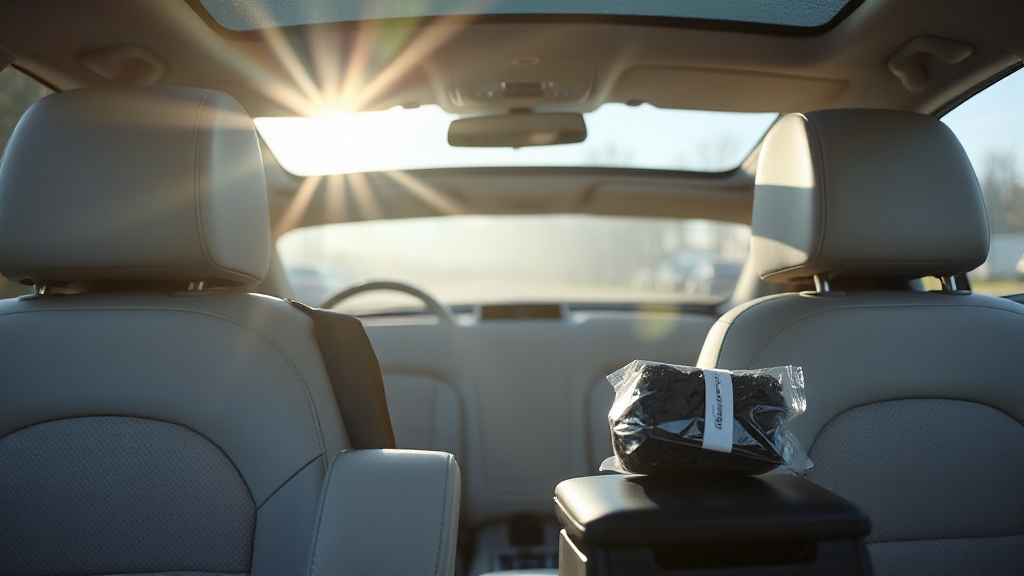
Although it might seem like a simple sensory experience, the new car smell results from complex chemical off-gassing of volatile organic compounds (VOCs) emitted by interior materials such as plastics, adhesives, and sealants.
Key contributors include phthalate plasticizers and anti-rust agents like trimethyl pentanediol diisobutyrate (TMPIBA), alongside compounds like formaldehyde, toluene, and benzene. These VOCs can sometimes impact air quality inside the vehicle, which is why components like cabin air filters play a role in improving passenger comfort.
This off-gassing intensifies in sealed environments and is accelerated by heat and sunlight.
You’ll notice the scent strongest when first opening your vehicle, but it gradually diminishes over weeks to months as VOC concentrations drop.
Factors like material composition, climate, and ventilation influence this lifespan.
Manufacturers often use light chambers that simulate various weather conditions to test and understand how these chemicals emit and fade over time.
Understanding this process helps you appreciate that the beloved new car aroma is a transient chemical phenomenon, not merely a fresh-clean scent.
Routine Interior Cleaning Tips to Maintain Freshness
To maintain your car’s interior freshness, you must establish a consistent cleaning routine targeting all odor sources. Regularly vacuum carpets, floor mats, upholstery, and under seats using attachments to reach crevices. Remove trash promptly to prevent odor buildup. Vacuum at least once a week for optimal cleanliness to keep dust and pet hair under control.
Wipe hard surfaces—dashboard, steering wheel, door panels—with microfiber cloths and pH-balanced cleaners that include UV protection to prevent damage. Disinfect high-touch areas to reduce bacteria. Using products with advanced synthetic technology can further protect interior materials from wear.
For upholstery, apply automotive-specific stain removers and odor neutralizers; shampoo carpets periodically and condition leather seats to avoid mustiness. Clean windows and mirrors with streak-free glass cleaner, and wipe door seals to reduce moisture-related odors.
Maintain this routine weekly or bi-weekly, immediately address spills, and avoid smoking inside the car. These precise steps will help preserve that desirable new car scent effectively.
Essential Air Vent and Cabin Filter Care
When you regularly clean your car’s air vents and replace the cabin air filter, you substantially improve interior air quality and preserve that fresh new car scent.
Start by turning off the engine and removing keys for safety. Use a handheld vacuum with a brush attachment to remove surface dust, then a soft-bristled brush or cotton swabs for vent slats.
Wipe vents with a microfiber cloth dampened in mild soap solution. Regularly cleaning air vents and ducts is essential to support a fresh interior environment. Utilizing a high-quality drop-in filter can also enhance filtration and maintain cleaner air inside the vehicle.
Turn off your engine, vacuum dust from vents, then wipe with a mild soap-dampened microfiber cloth.
Employ compressed air to clear deeper duct debris, directing airflow away from your face. Check the cabin air filter frequently and replace it according to manufacturer guidelines or when visibly dirty.
A clean filter traps dust, pollen, and contaminants, preventing odors and improving ventilation. Neglecting filter care risks bacterial and mold buildup, which degrades air quality and freshness.
Preventing Common Odor Sources Inside the Vehicle
Since odors inside a vehicle often originate from overlooked sources, proactively managing trash, food residue, and moisture is critical to preserving a fresh cabin environment. You should remove all trash promptly, avoid eating inside, and clean storage compartments regularly.
Maintain interior hygiene by vacuuming thoroughly and wiping surfaces with suitable cleaners. Control moisture by drying wet items before placing them inside and repairing leaks immediately.
It is important to note that the new car smell comes from volatile organic compounds (VOCs) emitted by interior materials, which can contribute to odors and affect air quality. Using products that reduce VOCs can help maintain a healthier environment.
| Odor Source | Prevention Technique |
|---|---|
| Trash & Food Residue | Immediate disposal, sealed containers |
| Interior Dirt | Frequent vacuuming, surface wiping |
| Moisture | Dry items, fix leaks, ventilate |
| Pet Odors | Regular cleaning, washable covers |
| Smoke & External Odors | No smoking, air out, replace filters |
Adhering to these steps reduces VOCs and maintains a fresh vehicle atmosphere. Additionally, just as extended oil change intervals contribute to vehicle maintenance, consistent interior care prolongs a vehicle’s pleasant environment.
Effective Use of Odor Absorbers and Fresheners
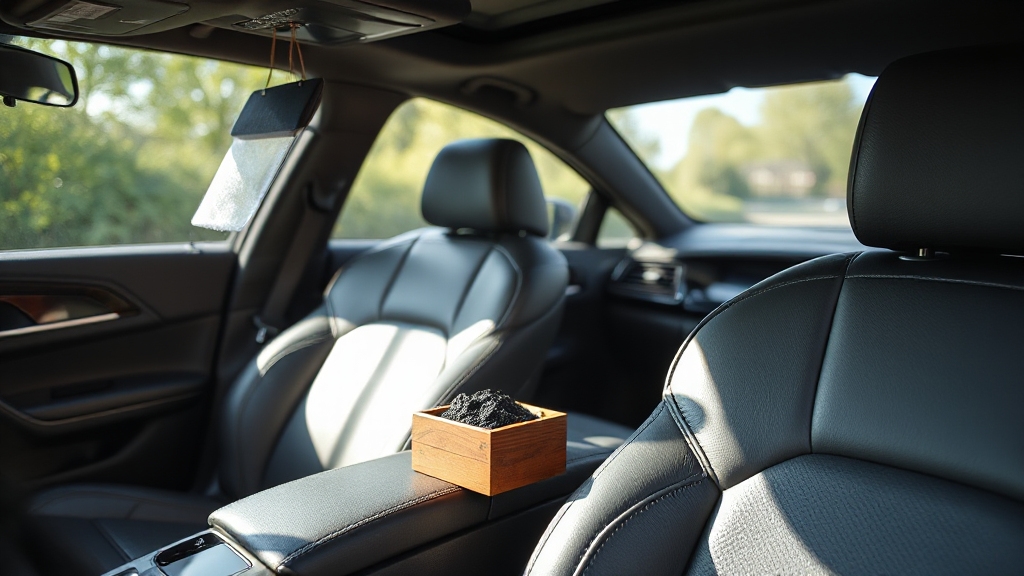
Managing odors inside your vehicle goes beyond removing visible sources like trash and moisture; you’ll also want to address lingering smells embedded in fabrics and surfaces.
Odor bombs, particularly those releasing chlorine dioxide gas, chemically neutralize odor molecules, effectively penetrating upholstery and hard-to-reach areas to eliminate mildew, smoke, and pet odors. These treatments eliminate odors permanently rather than just masking them, ensuring a truly fresh interior environment.
For ongoing control, natural absorbers like baking soda continuously neutralize mild odors but require periodic replenishment. Combining absorbers with lightly scented fresheners enhances the scent profile without overpowering.
Prior to application, clean and vacuum interior surfaces to maximize effectiveness. Using products with high lumens and precision can similarly improve visibility and maintain a fresh driving experience.
Regularly replacing cabin air filters prevents odor buildup. Maintaining dryness and using moisture-absorbing products reduce mold development, supporting long-term freshness. Employing these targeted methods will help you sustain that coveted new-car smell efficiently and reliably.
Benefits of Professional Detailing and Protective Treatments
You’ll benefit from professional detailing by removing deep-seated dirt and allergens that standard cleaning misses, enhancing interior air quality. This comprehensive process often uses specialized tools and products to reach hidden areas, ensuring a thorough clean.
Protective coatings applied during detailing shield your vehicle’s surfaces from UV damage, contaminants, and wear, preserving both appearance and function. These treatments extend your car’s lifespan while maintaining that fresh, new-car scent longer.
Choosing high-quality products similar to Moog’s durability standards can help ensure lasting protection and performance.
Deep Cleaning Benefits
Although regular cleaning keeps your car tidy, professional detailing offers deep cleaning benefits that go far beyond surface appearance. It targets embedded dirt, allergens, and odors that routine cleaning misses, enhancing both hygiene and comfort inside your vehicle.
This meticulous approach also preserves material integrity and vehicle value by addressing grime and contaminants at a microscopic level. Many modern car care products incorporate advanced technology to improve cleaning effectiveness and protect surfaces.
Key deep cleaning benefits include:
- Reduction of interior allergens by approximately 60%, improving air quality and eliminating persistent odors
- Thorough steam cleaning of upholstery and carpets to remove embedded dirt and microbes
- Extensive exterior cleaning that removes pollutants like road salt and tar, preventing corrosion and paint damage
- Detailed engine compartment cleaning to maintain component performance and longevity
- Additionally, waxing and polishing help protect the paint from UV rays and environmental contaminants, preserving the vehicle’s exterior finish.
These precise interventions ensure your car stays fresh, protected, and retains its showroom-level quality longer.
Protective Coating Advantages
When you invest in professional protective coatings, you shield your car’s paint from harsh environmental factors like UV rays, rain, and chemical pollutants that cause fading and cracking. These coatings form a durable barrier that enhances surface hardness and scratch resistance, preserving your vehicle’s glossy finish.
The rising demand for coatings that improve durability and aesthetic appeal supports the widespread adoption of these protective treatments, especially in the growing electric and autonomous vehicle segments market drivers. However, it is important to note that ceramic coatings provide limited protection against rock chips and high-velocity impacts.
Ceramic coatings, in particular, resist bird droppings, acid rain, and water spots, extending protection beyond traditional waxes. They provide exceptional waterproofing and chemical resistance, preventing rust and corrosion while maintaining flexibility to avoid cracking under temperature changes.
For enhanced impact protection, combining ceramic coatings with paint protection film offers a more comprehensive shield against road debris and chips.
Frequently Asked Questions
Can Certain Car Colors Affect the Perception of New Car Smell?
You might find it interesting that darker car colors can raise interior surface temperatures by up to 20°F compared to lighter shades. This increase accelerates the off-gassing of volatile organic compounds (VOCs), which intensifies the new car smell.
Does Parking in Direct Sunlight Intensify or Reduce the New Car Odor?
Parking in direct sunlight intensifies the new car odor initially because elevated interior temperatures accelerate VOC emissions from materials like upholstery and plastics. This heat triggers faster off-gassing of compounds such as formaldehyde, increasing odor strength temporarily.
However, sunlight also speeds up the overall VOC release process, causing the smell to peak sooner and fade earlier compared to shaded conditions, where VOC off-gassing occurs more gradually and the scent lasts longer.
Are There Any Health Risks Associated With Synthetic New Car Scent Products?
You know the saying, “Don’t judge a book by its cover”? Synthetic new car scent products might smell pleasant but pose health risks. They emit volatile organic compounds (VOCs) like toluene and formaldehyde, which can cause headaches, nausea, and respiratory irritation.
Prolonged exposure may damage your liver or kidneys and worsen asthma. So, it’s best to avoid these synthetic scents and opt for natural alternatives to protect your health.
How Do Hybrid and Electric Cars Compare in New Car Smell Intensity?
You’ll find that hybrid and electric cars generally have comparable new car smell intensity because both use similar interior materials that off-gas volatile organic compounds (VOCs). Sometimes hybrids emit stronger odors due to specific adhesives or plastics unique to certain models.
Can Aftermarket Seat Covers Impact the Longevity of the New Car Scent?
Like a filter that changes the air you breathe, aftermarket seat covers can affect your car’s new scent. Breathable fabric covers let air circulate, helping preserve the original smell longer, while synthetic covers may trap moisture and odors, accelerating scent loss.
Covers with odor-absorbing inserts actively neutralize smells. However, poorly maintained or ill-fitting covers can harbor bacteria and dust, degrading the fresh scent. Regular cleaning and proper fit are essential to maintain odor quality.
Make That New Car Scent Go the Distance
To keep that new car smell lasting, you need consistent care. Did you know the average new car scent fades within three months due to volatile organic compounds dissipating? Regularly cleaning the interior, maintaining air vents and cabin filters, and preventing odor sources are essential steps. Using odor absorbers and scheduling professional detailing further preserves freshness. By following these technical measures, you’ll extend the lifespan of that signature scent and maintain a pleasant driving environment.

